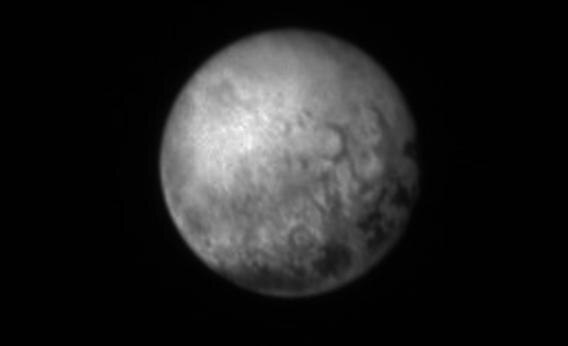Create a free profile to get unlimited access to exclusive videos, sweepstakes, and more!
Charon Revealed! Next Up: Pluto.

We are one day away from Pluto, folks. One. Day.
And things have already started. The New Horizons spacecraft is moving so rapidly—14 kilometers per second!—and Pluto and Charon are so small, that it’s only now that they are growing in size enough to confidently see details.
And holy wow, what details! On July 11, when New Horizons was just under 4 million kilometers (2.5 million miles) from Pluto, it took the phenomenal shot above of Pluto’s moon Charon.
Oh my! Look at all those features! On the right are some annotation of what we may be seeing. I have to agree with the assessment that the two big circular features are impact craters. The brighter material around them is common … though the one near the bottom of the picture appears to have an extended streak to the left. That may be a coincidence due to the still relatively low resolution of the picture (Charon is only about 50 pixels across in the original shot), or it may be something else. Hard to say.
The crater floors are dark, which may be due to different materials being exposed, excavated after the impact eons ago. As the press release also notes, bigger ice crystals reflect less light, so that might be behind the change in brightness.
The chasms are very interesting. They’re huge, roughly 100 kilometers across, and quite deep. Those are likely from faults in the surface. But again, I urge caution. These are still low-res images.
And Pluto is looking amazing now! Check this out:
That is a relatively unprocessed image from July 11 (from 4 million km); I grabbed it off the raw image site, enlarged it by a factor of roughly two, then dropped the brightness and increased the contrast by a little bit.
The weird dark regions are obvious at the bottom. Astronomer Mike Brown thinks they might be dark substrates left behind as frozen nitrogen ice evaporates at the warm(er) equator and redeposits at the pole. We see something similar on Saturn’s moon Iapetus, though with water ice. That would also explain why Pluto’s north pole is so shiny.
The darker linear features all over the surface on the right are interesting. Fault lines in the crust? Cracks from the crust shrinking? As Brown notes, they’re bound to intersect in several places, making them look like polygons, so that may be coincidence. Sometimes impacts create polygonal craters if the crater bowl intersects different kinds of material; that’s seen on many airless bodies.
Brown also thinks the brighter spots on Charon may be flows of water ice contaminated with ammonia. Water is normally frozen quite solidly at that distance from the Sun, but ammonia can act like an antifreeze where temperatures are warmest.
For a lot of this, we’ll know better in literally a few days (or weeks once the mineralogical analysis gets sent back to Earth). Unfortunately, New Horizons is a flyby mission; you can’t send a probe to Pluto in as short a time as nine years and also have it carry enough fuel to slow down and orbit. It’ll zip past Pluto and Charon in just a few hours. When it does, it will only fly over one part of Pluto at closest approach, and the dark features will be over the horizon, out of sight. Bummer.
You can find out more about the flyby, including timing, at Emily Lakdawalla’s blog at the Planetary Society. She also has links to places to watch for up-to-date info.
This is it, folks. This is Pluto. Tuesday at just before noon UTC (07:50 ET) the probe will make its lowest dive over the surface, take images, and start sending them back over the next two days. And then we’ll really see this strange, new world for the first time.


























